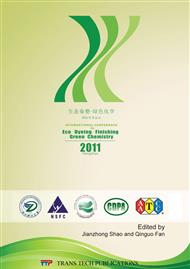[1]
J.K. Kim, Y.W. Mai, High strength, high fracture toughness fiber composites with interface control, Compos. Sci. Tech. 41 (1991) 333-345.
DOI: 10.1016/0266-3538(91)90072-w
Google Scholar
[2]
M.R. Piggott, Failure processes in the fiber-polymer interphase, Compos. Sci. Tech. 42 (1991) 57-65.
Google Scholar
[3]
R.Y. Qin, J.B. Donnet, Study of carbon fiber surface by scanning tunneling microscopy, Part Ⅲ carbon fibers after surface treatment, Carbon. 32 (1994) 323-328.
DOI: 10.1016/0008-6223(94)90195-3
Google Scholar
[4]
W.H. Lee, J.G. Lee, P.J. Reucroft, XPS study of carbon fiber surface treated by thermal-oxidation in mixture of O2/(O2+N2), Appl. Surf. Sci. 171 (2001) 136-142.
DOI: 10.1016/s0169-4332(00)00558-4
Google Scholar
[5]
J.M. Park, Y.M. Kim, K.W. Kim, Interfacial properties of ED carbon fiber reinforced epoxy composites using fragmentation techniques and acoustic emission, J. Colloid Interface Sci. 231 (2000) 114-128.
DOI: 10.1006/jcis.2000.7113
Google Scholar
[6]
R. Li, L. Ye, Y.W. Mai, Application of plasma technologies in fibre-reinforced polymer composites: a review of recent developments, Compos. Part A. 28 (1997) 73-86.
DOI: 10.1016/s1359-835x(96)00097-8
Google Scholar
[7]
W.J. Tomlinson, R.S. Barnes, Fiber coatings and the mechanical properties of carbon fiber/nylon 6 composites, J. Mater. Sci. Lett. 11 (1992) 440-441.
Google Scholar
[8]
H.Y. Ma, Y.D. Huang, L. Shao, et al, Modification of carbon fiber and improvement of interfacial adhesion in epoxy resin composites with Co60 radiation, In Proceedings of 13th International Conference on Composites Materials, Beijing, 2001, p. ID-1228.
Google Scholar
[9]
S. Periyasamy, M.L. Gulrajani, D. Gupta, Preparation of a multifunctional mulberry silk fabric having hydrophobic and hydrophilic surfaces using VUV excimer lamp, Surf. Coat. Tech. 201 (2007) 7286-7291.
DOI: 10.1016/j.surfcoat.2007.01.038
Google Scholar
[10]
Y. Huang, R.J. Young, Analysis of the fragmentation test for carbon-fiber/epoxy model composites by means of Raman Spectroscopy, Compos. Sci. Tech. 52 (1994) 505-17.
DOI: 10.1016/0266-3538(94)90033-7
Google Scholar
[11]
S.K. Ryu, B.J. Park, S.J. Park, J. Colloid Interf. Sci. 215 (1999) 167-169.
Google Scholar


